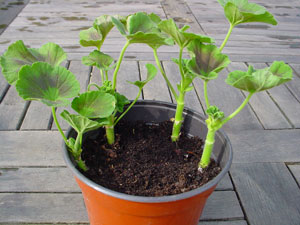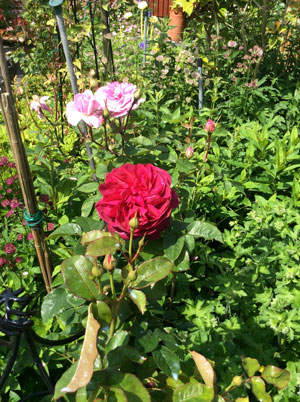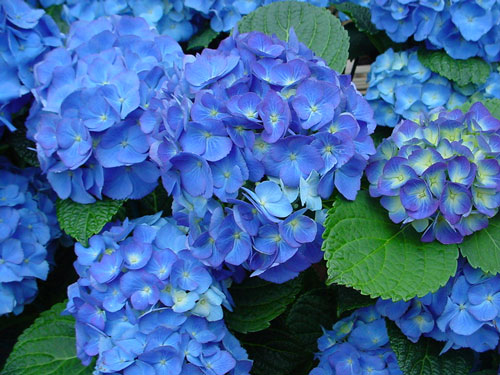August Garden Diary
Our August gardening diary is brought to you by Geoff Hodge of The Scotts Miracle-Gro Company – Lovethegarden.com
August is usually one of the warmest months of the year, with an average of six hours of sunshine every day, but there can still be periods of rain. Don’t be fooled by even torrential downpours or thunderstorms – this may not be enough to water many plants adequately. Enjoy your garden to the full this month. Take time for barbecues, picnics and eating outdoors – but have one eye on your plants to keep them looking great.
FLOWER BEDS & BORDERS
Cut back the old, damaged and diseased leaves of early summer-flowering perennials, such as geraniums and heucheras, to encourage a fresh flush of new, more attractive foliage. This will also keep the plants more compact and, with some plants such as geraniums, may also encourage a further flush of flowers. Always give the plants a good liquid feed after cutting them back to ensure strong, healthy regrowth and, where relevant, new flowers.
 This is the best month to take cuttings of fuchsias, pelargoniums, trailing petunias, osteospermums and other half-hardy, perennial patio and container plants ready for overwintering for next year. If you leave it until autumn, the cuttings may not be large enough to come through the winter successfully.
This is the best month to take cuttings of fuchsias, pelargoniums, trailing petunias, osteospermums and other half-hardy, perennial patio and container plants ready for overwintering for next year. If you leave it until autumn, the cuttings may not be large enough to come through the winter successfully.
Choose strong, healthy young growth that isn’t flowering. If you can’t find suitable shoots, cut back hard one or two at the back of the plants to encourage strong regrowth. Take cuttings 7.5-10cm (3-4in) long, cutting below a leaf joint, or node. Remove the leaves from the lower two-thirds of the stem and insert in pots of moist seed and cutting compost. Cover the pot with a plastic bag (except pelargoniums) or place in a propagator and place somewhere out of direct sunlight to root.
Buy winter and spring bedding plug plants and pot them up into 7.5-10cm (3-4in) pots of good potting compost. The sooner you get them started, the bigger the plants will be when you’re ready to plant them out in autumn.
Mulching borders with a 5-7.5cm (2-3in) thick layer of mulching material can help retain essential soil moisture and keep down the weeds. Always add mulches to already moist soil.
If you have gaps in your beds and borders, it’s a good idea to plug them with some new plants. Garden centres will have lots of good-sized summer-flowering plants that you can pop in now for instant colour and interest. Just make sure they are watered in well.
Topical tip
Start shopping for spring-flowering bulbs, placing orders with mail order specialists. The weather over the last year has been testing for bulb growers, and bulb harvests have been badly affected. Some bulbs may be in short supply in autumn, so get your orders in now to avoid disappointment.
PATIO GARDENING
Summer container displays may be looking a bit tired now after flowering for so long – but they can still go on providing colour and interest for many more weeks if they’re looked after properly. It is essential to water containers frequently – especially hanging baskets, which are very prone to drying out. This could mean every day during warm, sunny and/or windy weather. The aim should be to try and keep the compost evenly moist; you can always test the compost by pushing your finger into it and feeling if it’s damp.
If you’re away from home for most of the day and especially when you go away for weekends or longer holidays, watering becomes a bit of a problem. Installing a drip watering system and a battery-operated timer removes all the stress, as it does the watering for you!
Regular feeding with liquid plant foods – high potash ones for flowering plants – will give your plants all the energy they need to continue providing fabulous displays.
Flowering plants should also be deadheaded regularly once the flowers begin to fade. Remember to remove the developing seed head or seedpod as well as the flower and your plants will continue flowering right up to the first frosts of autumn.
Topical tip
Standing containers that dry out very quickly in plant saucers topped up with water will help keep the compost moist for longer.
LAWNS
In order to keep your lawn beautiful for the rest of the summer, it still needs regular looking after. Correct, regular mowing and good feeding will be essential, as will controlling any weeds that start to grow. Don’t cut the grass too short – aim to keep it around 4cm (11/2in) high. Doing this weekly is quicker than mowing less frequently, as you’ll empty the grass box less often! The grass will need feeding throughout summer. Whenever there are periods of prolonged dry weather, a liquid feed will be a better choice compared to a granular feed.
As long as the soil isn’t bone dry, now’s a good time to dig over areas you want to turn into a lawn in the autumn. Improving poor soil is important for good grass growth – and something many people don’t consider. While digging over the soil, add compost or lawn soil to ensure your new lawn gets off the best possible start. After digging over, leave the soil for a few weeks to allow weed seeds to germinate, then spray with a weedkiller or hoe them off. This will reduce weed competition when sowing a new lawn from seed.
Topical tip
Damaged edges should be repaired by cutting a new one with a half moon edging iron. Use a board or plank to get a good straight edge or use a hosepipe as a guide for curved edges.
GROW YOUR OWN
Vegetables
All vegetables will need a regular, constant supply of water at their roots. This will help strong, healthy growth, help to avoid diseases, disorders and bolting – running to seed prematurely – and tough or tasteless vegetables. Beans need sufficient water to help the pods set and prevent them becoming tough and stringy, and aubergine, courgette, cucumber, marrow, pepper, squash and tomato plants should be kept well watered so they produce the maximum number of well-flavoured fruit.
Ensure that all vegetables also get a regular supply of nutrients to ensure fabulous, tasty crops. This is especially true for all vegetables growing in containers. Liquid feeds work instantly and are the best choice at this time of year. All fruiting crops – including peas and beans – should be given a high potash liquid feed to ensure they continue flowering and setting fruit.
Take care when thinning out late-sown carrot seedlings to prevent the scent that is released attracting carrot fly. To protect carrots from carrot fly attack, cover the soil and developing plants with horticultural fleece.
Topical tip
Developing marrows and squashes should be raised off the ground slightly (place them on a tile or similar), to prevent direct contact with the soil, which can lead to rotting. If necessary, remove some of the older leaves to ensure the fruit receive plenty of direct sunlight.
Fruit
During dry spells water tree, bush and cane fruit thoroughly every seven to 14 days to ensure bumper crops. Pay particular attention to wall-trained fruit, especially stone fruit.
Mulching all fruit with a 7.5-10cm (3-4in) thick mulch will help retain soil moisture around the roots as well as keeping weeds away. Always add mulches to already moist soil. Branches of many fruit trees, but especially plums and greengages, often collapse and snap under the weight of fruit produced, so make sure you support branches producing heavy crops with a stout V-shaped stake.
Now’s the time to prepare new strawberry beds for planting up in the autumn or early next year. To ensure new plants grow and fruit well, improve the soil first with well-rotted manure or compost. Lift and pot up rooted strawberry runners. These will make new plants to fruit for the next five to six years and are useful replacements for old or diseased plants.
Cleanliness and hygiene are the best ways of preventing disease problems on fruit. Remove apples, pears and plums affected with brown rot to prevent this disease spreading to otherwise healthy fruit as well as causing possible problems next year. Gather fallen diseased leaves from apples and pears affected by scab, rust and other diseases and dispose of them. If bacterial canker is a problem on stone fruit trees, prune out affected branches – but have all pruning finished by the end of the month.
Topical tip
Tie in and train the new shoots of blackberries and hybrid berries. Always try to keep the new shoots separate from the older, fruiting ones to make pruning out the fruited shoots later in the year much easier.
TREES, SHRUBS, ROSES & CLIMBERS
This is the time to propagate a range of shrubs – such as ceanothus, choisya, hebe, hydrangea, lavender and philadelphus – from semi-ripe cuttings. Take cuttings 7.5-12.5cm (3-5in) long, cutting below a leaf joint, or node.
 Remove the leaves from the lower half to two-thirds of the stem, treat the cut end with hormone rooting powder or liquid and insert in pots filled with moist seed and cutting compost to the base of the lowest leaves. Place the pots in a cold frame, propagator or cover with a plastic bag and place them somewhere warm, but out of direct, burning sunlight.
Remove the leaves from the lower half to two-thirds of the stem, treat the cut end with hormone rooting powder or liquid and insert in pots filled with moist seed and cutting compost to the base of the lowest leaves. Place the pots in a cold frame, propagator or cover with a plastic bag and place them somewhere warm, but out of direct, burning sunlight.
Plants that can be difficult to root – including rosemary and lavender – are best propagated from heel cuttings. Carefully tear off a sideshoot about 10-12.5cm (4-5in) long from the main stem ensuring there’s a small sliver of bark – or ‘heel’ – attached at the base. And then treat the cuttings in the same way as above.
This is the best time of year to give most hedges a good trimming over. They will only grow a little after this before colder weather in autumn stops further growth. For best results, the sides of hedges should be slightly tapered, so that the base is wider than the top, resembling a flat-topped capital A. This allows light to reach the bottom of the hedge, so it doesn’t turn brown or die off.
Established lavender plants can be given a light trimming over after flowering. Lavenders produce lots of leggy, woody stems if not pruned regularly, so it is best to keep them compact, bushy and flowering well by pruning now and again in spring if necessary. Remove the faded flower heads and up to 2.5cm (1in) of the foliage with shears. Do not prune hard, cutting into older, leafless growth, as this will not re-shoot and the plant may die as a result.
Borderline hardy shrubs that may be susceptible to damage form cold, winter weather and frosts can be given a bit of ‘toughening up’. Feeding them this month with sulphate of potash will help ripen and toughen their wood and generally make them more resistant to cold damage.
Topical tip
Small holes and tears in new foliage of plants such as caryopteris, fuchsia and dahlia are most likely caused by capsid bug damage. A systemic insecticide will help provide protection from these pests.
GENERAL GARDENING JOBS
Make sure water butts are ready for replenishing should we get any rain during the month. If yours is empty, give it a good clean out to help prevent the water turning sour.
Torrential downpours hitting dry and compacted soil at this time of year can result in a lot of soil wash-off. So either hoe or lightly fork the soil to prevent this happening and to allow the rain to penetrate the ground.
As weeds are growing prolifically this year, make sure to keep on top of controlling them so they don’t get out of hand.
Topical tip
Continue to keep a regular eye on plants susceptible to pests and diseases and be on the look out for weeds. Deal with any you see quickly before they get out of control and become a problem to control.
HOUSEPLANTS
Check on any houseplants that have been placed outside for a refreshing summer ‘holiday’. Be particularly watchful for any pests they may pick up – especially aphids, mealybug, red spider mite and whitefly – and if you see signs of these pests, deal with them by spraying with a systemic insecticide.
Houseplants may be particularly at risk from vine weevil attack, the adults of which will be looking for somewhere to lay their eggs this month. If you see signs of these pests, treat the compost with a liquid vine weevil killer compost drench.
Topical tip
Foliage houseplants will certainly benefit from misting regularly – at least daily – to help improve humidity around the leaves. But never do this when the plants are receiving direct sunlight.
Use plant protection products & biocides safely. Always read the label and product information before use. Pay attention to the risk indications and follow the safety precautions on the label.
For full information on all Scotts Miracle-Gro products, visit lovethegarden.com



